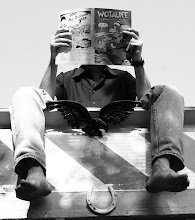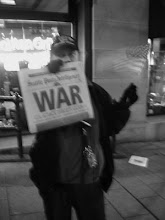
1989: It’s early July, a typical mid-summer day in rural Western Pennsylvania, cicadas are slicing the muggy air, their shrill, metallic wing-song guitar to the bass growling of a dozen mowers, while, high above, chickadees and chickarees do battle, a pained orchestra of squeals and squawks issuing from the waving wall of conifers that line three sides of the tidy garden I am standing in, leaning into the shade of a large oak, staring at a postcard I've just pulled from my parent's mailbox. It's from Aline Kominsky-Crumb, cartoonist and wife of Robert Crumb, the king of underground comix.
I've recently moved back into my parent’s house, a semi-occasional event, one customarily preceded by a year or two in the city of Pittsburgh, living in artistic poverty, scraping together rent and food money with a variety of unusual jobs. I've fumigated mushroom-strewn, flea-infested slum apartments, posed clothesless before university art students, appeared at wine and cheese functions dressed as a nine-foot tall puppet of industrialist Andrew Carnegie, ridden a messenger bike, emptied cans of cigarette ash and carbon paper, scrubbed toilets, sold records, painted horrible murals at health spas (one featuring a bench-pressing Hulk, no less), and loitered about downtown dressed as a clown. I even held a short-lived stint as staff illustrator for the Pittsburgh Post-Gazette. A sundry of ultimately miserable gigs, activities that crushed and hardened a young heart.
Having endured yet another run through this odd gauntlet of servitude, broken in both pocket and spirit, I literally headed for the hills, the rolling, thickly-wooded, glacial cuts of Northern Butler County, rural territory among which I’d spent most of my teenage years. Successfully turning twelve months of lunch breaks into a crash course in cartooning, immersing myself in numerous old books on the classic American cartoonists; Roy Crane, Elzie Segar, and Bud Fisher, among others, I'm now determined to focus on a career in the great inky art, the only thing I can contemplate doing for the rest of my life.
Having endured yet another run through this odd gauntlet of servitude, broken in both pocket and spirit, I literally headed for the hills, the rolling, thickly-wooded, glacial cuts of Northern Butler County, rural territory among which I’d spent most of my teenage years. Successfully turning twelve months of lunch breaks into a crash course in cartooning, immersing myself in numerous old books on the classic American cartoonists; Roy Crane, Elzie Segar, and Bud Fisher, among others, I'm now determined to focus on a career in the great inky art, the only thing I can contemplate doing for the rest of my life.
I’d made my first step towards this goal earlier that year, in April, when the editor of the San Diego Reader had accepted half a dozen strips I’d prospectively mailed her way. These appeared under the banner “A Sleepyhead Tale”, containing quasi-humorous, mostly surreal depictions of my actual dreams. Hesitant, but serviceable, they nonetheless proved popular enough with San Diegans to land me a regular weekly feature, one which ran for almost four years, picking up a few precious additional papers as it went.
The note Aline Kominsky-Crumb has scrawled across the back of the postcard expresses interest in running a handful of my A Sleepyhead Tale strips in the next issue of Weirdo, Crumb’s infamous and influential cartoon “scrapbook”, a publication both revered and reviled for his generously catholic editorial policy. I'm to be included in issue #27, which Robert and Aline are co-editing.
I am, understandably, ecstatic at this news. Here is recognition from the “man”, R. Crumb, the godfather of alternative cartooning.
I am, understandably, ecstatic at this news. Here is recognition from the “man”, R. Crumb, the godfather of alternative cartooning.
My head spinning, I stride about the garden, reading the card over and over, the hum of the cicada now just an echo to my own wing-song of victory. I‘ve made it, I think giddily, seeing myself heading straight to the top of my chosen profession. A few weeks of perseverance in the clammy studio I’d arranged in my parent’s basement, struggling with a pen, quickly migrating to brush, dutifully attempting to master my chosen craft, and here I was, ready to take my place in the back seat of an imagined balloon-tired jalopy, one driven by Elzie Segar, creator of Popeye. I'd soon be finding myself cavorting, smoking stogies with co-passengers like Roy Crane, Bud Fischer, George Herriman, Jack Kirby, and Mr. Robert Crumb himself, all of us legends in our field, all jammed together, happily bouncing along, headed towards a brilliant cartoon sunset.
“JER-A-MEE!” comes a sudden, shrill cry, instantly splintering the divine, shattering the stained-glass panels of my four-color daydream. “MY LETTUCE!”
“Sorry!” I quickly reply, pocketing the postcard, my brain still racing down that funny paper pathway. I’ve walked right across my mother’s vegetable garden, a minor calamity I should have taken as the first sign of a less-than-smooth ride ahead, for it seems fate has other plans for this rookie ink-slinger.
It isn’t long before I find myself in the dreary waiting room of expectation, every day looking for another card, word on the imminent publication of Weirdo #27, but none arrives. The endless, muggy days crawl by, turning into weeks, soon a month, and still no news. Disappointment begins to gather about me, great grey bulkheads, burying my hopes in their shadow.
Being an all but penniless twenty three year-old, holding neither a driver’s license nor the money to travel, I am stuck in the wholly uncultured northern fringes of the American rust belt, my only connection to the greater art and cartooning world coming in the form of a subscription to the popular trade publication, The Comics Journal. It’s here, in late summer, that I read the crushing report of the Crumb’s sudden termination of Weirdo and their own flight to the hills, those of rural, Southern France.
This news leaves me a wreck, a Schleprock of my own ambitious overdrive, carrying the thunderous, yellowy-green skies of August with me, my heart as heavy as the humidity that seems to cling to the entire world. Nevertheless, having a weekly strip to produce, I carry on, reluctantly bidding farewell to the far-reaching boundaries of my own hope.
It isn’t until late fall of that same year that I find myself racing back to those outer reaches of aspiration.
I receive a phone call, from a friendly-sounding gentleman who introduces himself as “a volunteer fireman and amateur cartoonist from Cotati, California”. His name is Mark Landman and he’s contacted me after having been sent a thick envelope, a bulging, paper pierogi of cartoons, marked on the outside with a concise “THE GOOD STUFF”. It was from Robert Crumb. Inside were photocopies of all the comics he’d had set aside for that final, fatal, aborted issue of Weirdo. This strange, trans-Atlantic offering had arrived on Mark’s doorstep due to the fact that he’d recently been corralled, by publisher Denis Kitchen, into editing a new comics anthology, a Weirdo surrogate to be named Buzz. Two pages will be set aside for my work, putting me in the company of artists like Daniel Clowes, Jim Woodring, and Drew Friedman, along with Mark’s own pioneering, computer-drawn strips.
My heart rejoices. The cicada are humming again, even buzzing, you might say. I can make out the snowy peaks of Hope, breaking the horizon. My mind racing, I rush to catch up with that speeding jalopy…
“Slow down, Mr. Segar, I just lost my hat!” I cry, bounding into the back seat, finding myself shoulder-to-shoulder with Robert Crumb.
“Hat schmat, kid, thank yer lucky stars spinach-brain here saw you in time to slow down,” comes a gruff reply. I look to the front, to see Roy Crane, the creator of Wash Tubbs and Cap’n Easy. “Well, are you going to thank the man or not?” he asks.
My mind still reeling from the news of my imminent publication, I turn nervously to Crumb, barely whispering, “Thank you, Mr. Crumb, thank you very much.”
Crane shakes his head. “What are you thanking that low-brow hippie for?” he grunts, pointedly ignoring any reply I might have in me.
But I don’t care, I think to myself, I’m on my way, I’m really on my way!
























































